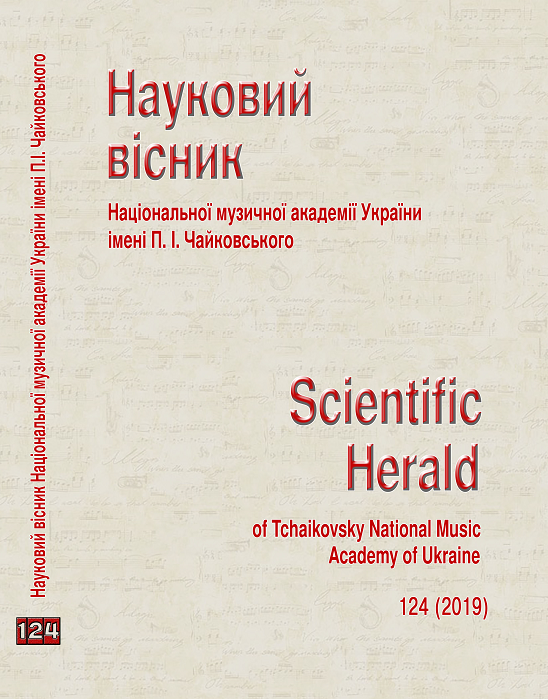Art rock concert practice and its projection into the XXI<sup>st</sup> century
DOI:
https://doi.org/10.31318/2522-4190.2019.124.165409Keywords:
rock culture, art rock, concert practice, studio audio recordingsAbstract
Relevance of the study. In the space of modern music, a special cluster is formed by the classics of art rock – musical works that were created during the end of the 1960s – the first half of the 1970s and haven’t yet lost their artistic value, force of conviction and power of influence over their audience. Though mostly reproduced as records nowadays, they are still often used at concerts forming a special stream of modern music life. A come-back of the highest achievements of art rock being at the interface between the entertaining and the academic music and bearing the high artistic and intellectual value into the concert practice requires careful attention from researchers.
The main objective of the study is to describe the specifics of concert practice of art rock at runtime, from the classic period till the last twenty years’ period.
Methodology. The main in the study is the comparative method that allows us to clarify the similarities and the differences in presentation of art rock musical works at the different stages of the musical cultural process.
Results and conclusions. The study allowed us to describe some parameters of the process of change of art rock concert practice. The classic period of art rock that is from the second half of the 1960s till the mid-1970s was marked by substantial difficulties in an arrangement of shows including those related to incompleteness of instruments. As a result, the depth and scale of the author's intention contradicted the real possibilities of its implementation, which stimulated the search for successful problem solving. Closer to the 1980s, art rock divides into layers: some bands go out of existence or make a long break in their activities, the others slightly change their style focus. Not all but just a few art rock representatives have stayed true to themselves. At the beginning of the XXIst century, with a rising tide of interest towards the classics of art rock on a concert stage, for a number of reasons it leaks away its authenticity as an artistic phenomenon in which the composer and the singer are impersonated all in one.
Downloads
References
Palii, I. O. (2012). Transduction as a phenomenon of music culture (as illustrated by piano pieces cycle of M. Mussorgsky «Pictures from Exhibition» and legasy of King Crimson and Pink Floyd rock-bands) [Transduktsiia yak yavyshche muzychnoi kultury (na prykladi fortepiannoho tsyklu M. Musorhskoho «Kartynky z vystavky» i tvorchosti rok-hurtiv King Crimson ta Pink Floyd)] : extended abstract of Diss. ...Cand. Degree of Ph.D. in Arts : 17.00.03 – Musical Arts. Kharkiv: Kharkivskyi National Kotliarevsky University of Arts, 16 p. [in Ukrainian].
Palkina, I. I. (2017). Genre genesis in rock-art: interspecific and intraspecific interactions [Zhanroutvorennia u rok-mystetstvi: mizhvydovi ta vnutrishnovydovi vzaiemodii] : extended abstract of Diss. ...Cand. Degree of Ph.D in Arts : 26.00.01 – Theory and History of Culture. Kyiv: National Academy of Government Managerial Staff of Culture and Arts, 16 p. [in Ukrainian].
Savytskaja, E. A. (2008). King Crimson. Great Deceivers : musicological investigation [King Crimson. Velikie obmanshhiki: muzykovedcheskie issledovanija]. Moscow: Galina E.G., 368 p. [in Russian].
Savytskaya, E. A. (1999). Principles of style synthesis of rock-music (as exemplified in foreign hard- and art-rock of 60-70-s.) [Principy stileobrazovanija v rok-muzyke (na materiale zarubezhnogo hard- i art-roka 60-70-h godov)]: Diss ...Cand. Degree of Ph.D in History of Arts : 17.00.02 – Musical Arts. Moscow: State Institute for Art Studies, 282 p. [in Russian].
Syrov, V. (2008). Style metamorphoses of rock [Stilevye metamorfozy roka]. Sankt-Peterburg: Kompozitor·Sankt-Peterburg, 312 p. [in Russian].
Khmel, N. (2018). Specific of bandura adaptation of Baroque music: interpretative-textological aspect [Spetsyfika bandurnykh perekladen muzyky Baroko: vykonavsko-tekstolohichnyi aspekt]: extended abstract of Diss. ...Cand. Degree of Ph.D. in Arts : 17.00.03 – Musical Arts. Odesa: The Odesa National Nezhdanova Academy of Music, 19 p. [in Ukrainian].
Cuker, A. M. (1993). And rock, and symphony... [I rok, i simfonija...]. Moscow: Kompozitor, 304 p. [in Russian].
Art rock. In: The Editors of Encyclopaedia Britannica, Encyclopaedia Britannica. Available at: https://www.britannica.com/art/art-rock (Accessed 05 Oct. 2018). [in English].
Awde, N. (2008). Mellotron: The Machine and the Musicians. Asian Studies Book Services, 590 р. [In English].
Bowler, D. and Dray, B. (1992). Genesis: A Biography. London: Sidgwick & Jackson, 294 p. [in English].
Starr, L. and Waterman, C. A. (2006). Art rock. American Popular Music: from Minstrelsy to MP3. 2nd ed. USA: Oxford University Press, 515 р. Available at: https://web.archive.org/web/20080503032559/http://www.us.oup.com/us/companion.websites/019530053X/studentresources/chapter11/key_terms/(Accessed 05 Oct. 2018) [in English].
Downloads
Published
How to Cite
Issue
Section
License
Our journal abides by the CREATIVE COMMONS copyright rights and permissions for open access journals.
Authors, who are published in this journal, agree to the following conditions:
The authors reserve the right to authorship of the work and pass the first publication right of this work to the journal under the terms of a Creative Commons Attribution License, which allows others to freely distribute the published research with the obligatory reference to the authors of the original work and the first publication of the work in this journal.
The authors have the right to conclude separate supplement agreements that relate to non-exclusive work distribution in the form in which it has been published by the journal (for example, to upload the work to the online storage of the journal or publish it as part of a monograph), provided that the reference to the first publication of the work in this journal is included.




